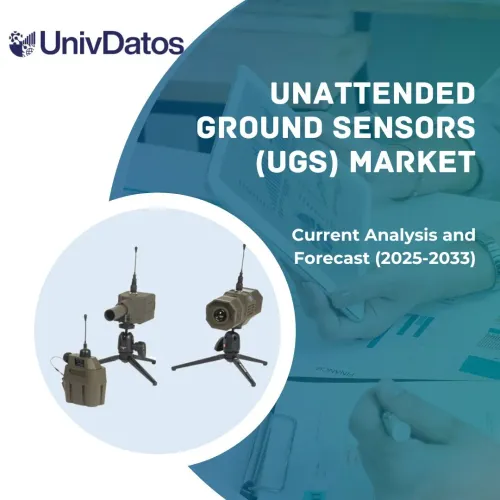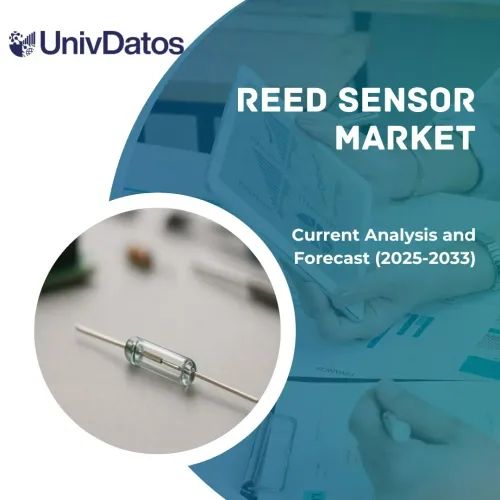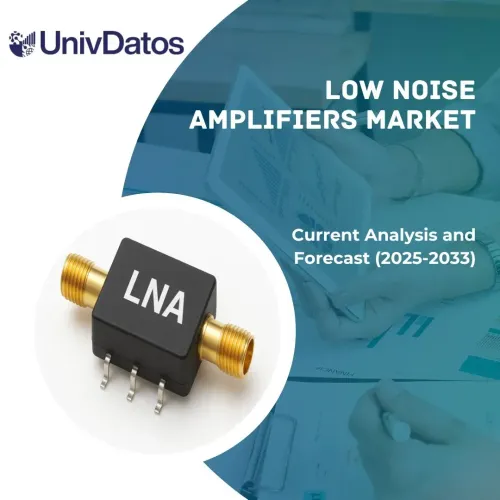- Home
- About Us
- Industry
- Services
- Reading
- Contact Us
3D Laser Snapshot Sensor Market: Current Analysis and Forecast (2025-2033)
Emphasis On Type (Up to 50 mm, 50-200 mm, 200-800 mm, and above 800 mm), By Application (Automotive, Healthcare, Manufacturing, Retail, Telecommunication, Others), and Region/Country
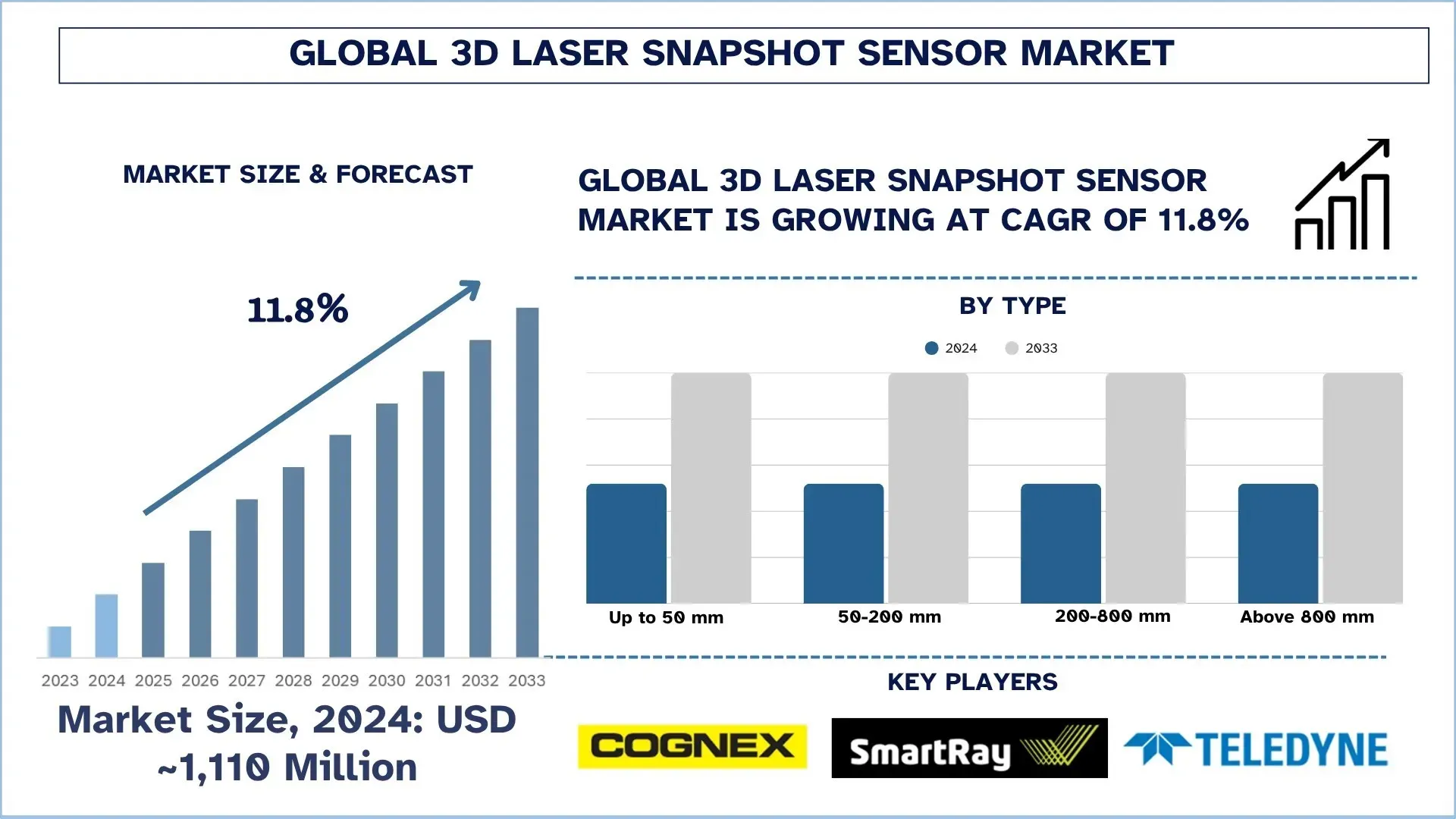
Global 3D Laser Snapshot Sensor Market Size & Forecast
The global 3D Laser Snapshot Sensor market was valued at USD 1,110 million in 2024 and is expected to grow to a strong CAGR of around 11.8% during the forecast period (2025-2033F), owing to the rising application in consumer goods and automotive industries.
3D Laser Snapshot Sensor Market Analysis
The global 3D Laser Snapshot Sensor market is growing at a rapid rate due to the increasing multiplicity of integration in key sectors such as automotive, consumer electronics, robotics, and industrial automation. The main demand generator has been the leverage of precision depth sensing and real-time 3D imaging. Since technology has become advanced and more accessible, industries are adopting 3D snapshot sensors at a very rapid pace for mere functions like facial recognition, object tracking, gesture control, and environmental mapping. Advanced driver-assistance systems and autonomous vehicles especially keep pushing the integration of such sensors in passenger and commercial vehicles. Rising consumer demand for smart functionalities in electronic devices are equally instrumental toward this growing demand.
Global 3D Laser Snapshot Sensor Market Trends
This section discusses the key market trends that are influencing the various segments of the global 3D Laser Snapshot Sensor market, as found by our team of research experts.
Expansion in Automotive Applications:
The automotive industry finds itself increasingly incorporating 3D laser snapshot sensors with the view of enhancing safety, automation, and in-cabin user experience. These sensors have found application in ADAS, primarily for object detection, pedestrian recognition, and environmental mapping-around the prerequisite for semi- and fully autonomous vehicles.
Inside the vehicle, 3D sensors help the driver monitoring systems track head positions, eye motions, or signals of distraction or fatigue, which can be critical in accident prevention. These sensors also facilitate a smart cabin to support gestures, occupant detection, or climate/seat modification on demand.
As automakers are working extensively toward higher levels of automation and user experience, there has been an increasing demand for real-time, high-resolution 3D sensing. As snapshot sensors can capture dynamic scenes within a fraction of a second, they come in quite handy for a fast-changing environment that the automotive world truly is. With regulations backing and the consumers supporting vehicle safety, this trend should intensify further.
3D Laser Snapshot Sensor Industry Segmentation:
This section provides an analysis of the key trends in each segment of the global 3D Laser Snapshot Sensor market report, along with forecasts at the global, regional, and country levels for 2025-2033.
The 50-200 mm Category has shown promising growth in the 3D Laser Snapshot Sensor Market.
Based on Type, the global 3D laser snapshot sensor market is segmented into up to 50 mm, 50-200 mm, 200-800 mm, and above 800 mm. Of these, the 50-200 mm segment has held the major share of the market. These have commanded market dominance as they are largely used in industrial automation, robotics, and quality inspection industries, which prefer moderate-range sensors offering a good compromise between accuracy and range. These sensors suit compact systems requiring accurate depth measurement within confined spaces. Moreover, these solutions became more in demand thanks to higher miniaturization and cheaper methods of manufacturing in electronics and automotive production.
Automotive Category Dominates the 3D Laser Snapshot Sensor Market.
Based on applications, the market is segmented into automobile, healthcare, manufacturing, retail, telecommunication, and others. Based on application segmentation, the automotive sector maintains top market share within the global 3D laser snapshot sensor market. This dominance is essentially caused by the ever-increasing utilization of these sensors in ADAS and the ongoing development of autonomous vehicles. 3D laser sensors provide highly accurate depth perception and real-time imaging for various functions such as collision avoidance, lane-keeping, and object detection. Furthermore, car manufacturers integrate this type of sensor within their production lines to enhance precision for quality control and robotic assembly, thereby paving the way for even higher demand. The continuous innovation and safety emphasis by the automotive sector keep this as the leading user of technology.
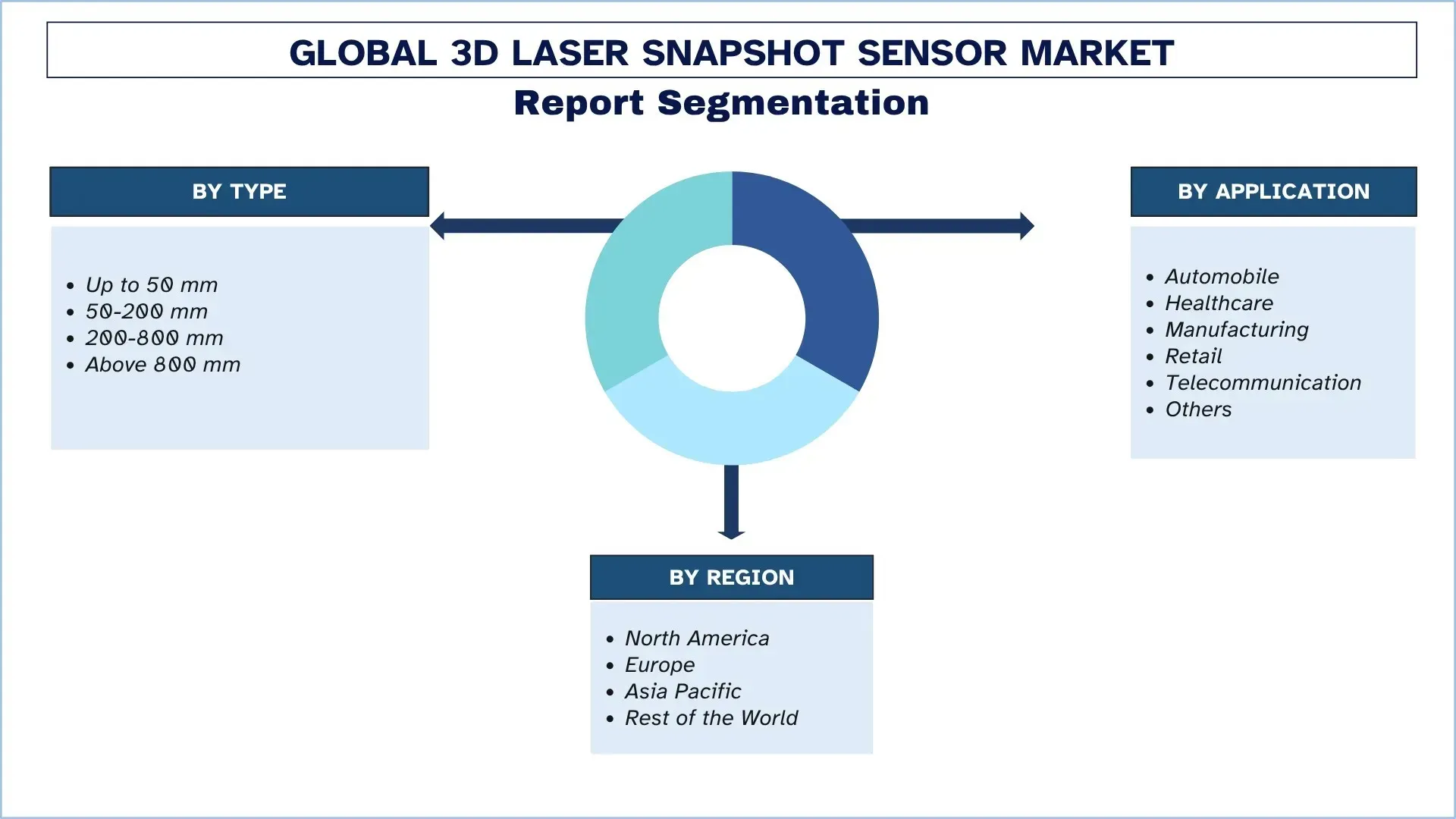
North America is expected to grow at a considerable rate during the forecast period.
Industries such as automotive, electronics, aerospace, and manufacturing are huge consumers of these sensors, triggering the imports of 3D laser snapshot sensors, thus leading to the dynamic development of the market in North America. The numerous technology firms and sensor manufacturers in the region have led to the innovation and early adoption of the latest sensing technologies. The United States, in particular, leads the region due to its advanced industrial automation infrastructure, capability of conducting research, and increasing focus on smart manufacturing and quality control.
One of the main industries providing growth in North America is automotive, wherein 3D laser snapshot sensors find increasing use in driver assistance systems, autonomous navigation, and in-vehicle monitoring. These sensors provide high-speed and high-resolution 3D imaging, which is essential for precision and safety in real-time scenarios. On the other hand, electronics and consumer goods industries use these sensors for measurement and inspection tasks on the production lines.
The U.S. held a sizeable share of the North America 3D Laser Snapshot Sensor market in 2024.
With the growing demand from leading industries such as the automotive, aerospace, and advanced manufacturing sectors, the U.S. stands as the predominant country for the adoption and development of 3D laser snapshot sensors. At the forefront of innovation in this space are U.S. companies that are integrating these sensors into robotics, quality control systems, and autonomous vehicles. These sensors demand high precision and fast response time, are taught Artificial Intelligence, and interface with machine vision platforms; hence, they cannot be missing from a modern production scenario. Growth and technological advancements in this highly dynamic market continue to be fueled by the country's inclination toward automation and digital transformation and the active collaboration between technology companies and academic research institutes.
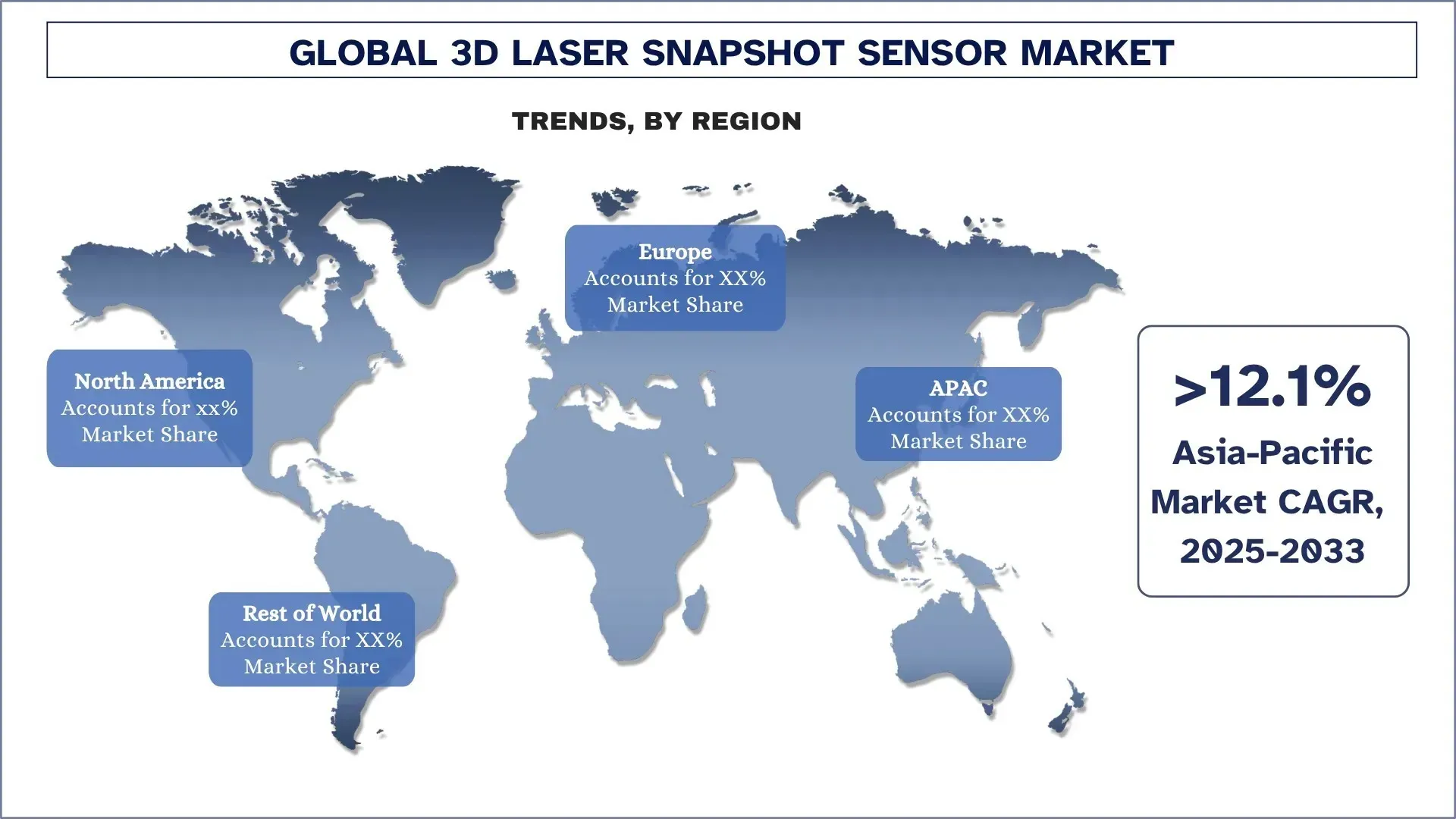
3D Laser Snapshot Sensor Industry Competitive Landscape:
The global 3D Laser Snapshot Sensor market is competitive, with several global and international market players. The key players are adopting different growth strategies to enhance their market presence, such as partnerships, agreements, collaborations, new product launches, geographical expansions, and mergers and acquisitions.
Top 3D Laser Snapshot Sensor Companies
Some of the major players in the market are KEYENCE, Cognex, SICK, SmartRay, Micro-Epsilon, Teledyne DALSA, Zebra Technologies Corp., Hikrobot, Vision Components, and LMI Technologies.
Recent Developments in the 3D Laser Snapshot Sensor Market
For instance, in 2024, Keyence launched the LJ-S8000 Series 3D Laser Snapshot Sensor with internal motor-driven scanning, eliminating the need for external lighting, lenses, a moving stage, or an encoder.
Global 3D Laser Snapshot Sensor Market Report Coverage
Report Attribute | Details |
Base year | 2024 |
Forecast period | 2025-2033 |
Growth momentum | Accelerate at a CAGR of 11.8% |
Market size 2024 | USD 1,110 Million |
Regional analysis | North America, Europe, APAC, Rest of the World |
Major contributing region | North America is expected to dominate the market during the forecast period. |
Key countries covered | U.S., Canada, Germany, U.K., Spain, Italy, France, China, Japan, South Korea, and India |
Companies profiled | KEYENCE, Cognex, SICK, SmartRay, Micro-Epsilon, Teledyne DALSA, Zebra Technologies Corp., Hikrobot, Vision Components, and LMI Technologies. |
Report Scope | Market Trends, Drivers, and Restraints; Revenue Estimation and Forecast; Segmentation Analysis; Demand and Supply Side Analysis; Competitive Landscape; Company Profiling |
Segments Covered | By Type, By Application, By Region/Country |
Reasons to Buy the 3D Laser Snapshot Sensor Market Report:
The study includes market sizing and forecasting analysis confirmed by authenticated key industry experts.
The report briefly reviews overall industry performance at a glance.
The report covers an in-depth analysis of prominent industry peers, primarily focusing on key business financials, type portfolios, expansion strategies, and recent developments.
Detailed examination of drivers, restraints, key trends, and opportunities prevailing in the industry.
The study comprehensively covers the market across different segments.
Deep dive regional-level analysis of the industry.
Customization Options:
The global 3D Laser Snapshot Sensor market can further be customized as per the requirements or any other market segment. Besides this, UnivDatos understands that you may have your own business needs; hence, feel free to contact us to get a report that completely suits your requirements.
Table of Content
Research Methodology for the Global 3D Laser Snapshot Sensor Market Analysis (2023-2033)
We analyzed the historical market, estimated the current market, and forecasted the future market of the global 3D Laser Snapshot Sensor market to assess its application in major regions worldwide. We conducted exhaustive secondary research to gather historical market data and estimate the current market size. To validate these insights, we carefully reviewed numerous findings and assumptions. Additionally, we conducted in-depth primary interviews with industry experts across the 3D Laser Snapshot Sensor value chain. After validating market figures through these interviews, we used both top-down and bottom-up approaches to forecast the overall market size. We then employed market breakdown and data triangulation methods to estimate and analyze the market size of industry segments and sub-segments.
Market Engineering
We employed the data triangulation technique to finalize the overall market estimation and derive precise statistical numbers for each segment and sub-segment of the global 3D Laser Snapshot Sensor market. We split the data into several segments and sub-segments by analyzing various parameters and trends, by Type, by Application, and by regions within the global 3D Laser Snapshot Sensor market.
The Main Objective of the Global 3D Laser Snapshot Sensor Market Study
The study identifies current and future trends in the global 3D Laser Snapshot Sensor market, providing strategic insights for investors. It highlights regional market attractiveness, enabling industry participants to tap into untapped markets and gain a first-mover advantage. Other quantitative goals of the studies include:
Market Size Analysis: Assess the current forecast and market size of the global 3D Laser Snapshot Sensor market and its segments in terms of value (USD).
3D Laser Snapshot Sensor Market Segmentation: Segments in the study include areas by Type, by Application, and by
Regulatory Framework & Value Chain Analysis: Examine the regulatory framework, value chain, customer behavior, and competitive landscape of the 3D Laser Snapshot Sensor industry.
Regional Analysis: Conduct a detailed regional analysis for key areas such as Asia Pacific, Europe, North America, and the Rest of the World.
Company Profiles & Growth Strategies: Company profiles of the 3D Laser Snapshot Sensor market and the growth strategies adopted by the market players to sustain in the fast-growing market.
Frequently Asked Questions FAQs
Q1: What is the global 3D Laser Snapshot Sensor market’s current market size and growth potential?
The global 3D Laser Snapshot Sensor market was valued at USD 1,110 Million in 2024 and is expected to grow at a CAGR of 11.8% during the forecast period (2025-2033).
Q2: Which segment has the largest share of the global 3D Laser Snapshot Sensor market by Type?
The 50-200 mm segment led the market in 2024. These have commanded market dominance as they are largely used in industrial automation, robotics, and quality inspection industries, which prefer moderate-range sensors offering a good compromise between accuracy and range.
Q3: What are the driving factors for the growth of the global 3D Laser Snapshot Sensor market?
• Rising Demand in Consumer Electronics: The notable rise of consumer gadgets across the globe, such as smartphones, tablets, AR/VR headsets, and smart home devices, in the 3D laser snapshot sensor market is fueling the growth.
• Integration with AI and Machine Learning: As AI and ML technologies see an ever-increasing use in industrial and commercial applications, there is a corresponding elevation of the capabilities of 3D laser snapshot sensors. Intelligent analytics utilize the powers of AI to embed into the system for the detection of 3D data in real time.
Q4: What are the emerging technologies and trends in the global 3D Laser Snapshot Sensor market?
• Expansion in Automotive Applications: The automotive industry finds itself increasingly incorporating 3D laser snapshot sensors with the view of enhancing safety, automation, and in-cabin user experience. These sensors have found application in ADAS, primarily for object detection, pedestrian recognition, and environmental mapping-around the prerequisite for semi- and fully autonomous vehicles.
• Growth in Wearable Technology: The rapid growth of wearable technology is pushing the demand for 3D laser snapshot sensors. Nowadays, 3D sensing is placed into smartwatches, fitness trackers, and even AR glasses for a better user interaction or to provide some new functionality.
Q5: What are the key challenges in the global 3D Laser Snapshot Sensor market?
• High Cost of Implementation: 3D Laser Snapshot Sensors are expensive due to advanced components and precision manufacturing. This limits adoption in cost-sensitive markets despite their performance benefits, especially in mid-range automotive and consumer electronics.
• Privacy and Data Security Concerns: These sensors collect sensitive data like facial features and movement patterns. Without strong data protection, they raise privacy risks. Regulatory compliance and secure handling are essential for user trust and wider adoption.
Q6: Which region dominates the global 3D Laser Snapshot Sensor market?
The North America region dominates the global 3D Laser Snapshot Sensor market due to the rising demand for automobiles, manufacturing, and consumer goods segments.
Q7: Who are the key players in the global 3D Laser Snapshot Sensor market?
Some of the top 3D Laser Snapshot Sensor companies include:
• KEYENCE
• Cognex
• SICK
• SmartRay
• Micro-Epsilon
• Teledyne DALSA
• Zebra Technologies Corp.
• Hikrobot
• Vision Components
• LMI Technologies
Q8: What are the opportunities for companies within the Global 3D laser snapshot sensor market?
Companies can tap into the growing demand in autonomous vehicles, smart manufacturing, and consumer electronics. Opportunities lie in offering compact, AI-integrated, and energy-efficient 3D sensors for applications like driver monitoring, facial recognition, and robotic automation. Expanding adoption in wearables and AR/VR also presents a strong growth avenue.
Q9: How can stakeholders navigate technological advancements in the 3D Laser Snapshot Sensor market?
Stakeholders should focus on AI-driven data processing, miniaturization, and integration with IoT platforms. Investing in R&D, forming tech partnerships, and staying aligned with industry standards can help adapt to rapid innovation and maintain a competitive edge in this fast-evolving market.
Related Reports
Customers who bought this item also bought




